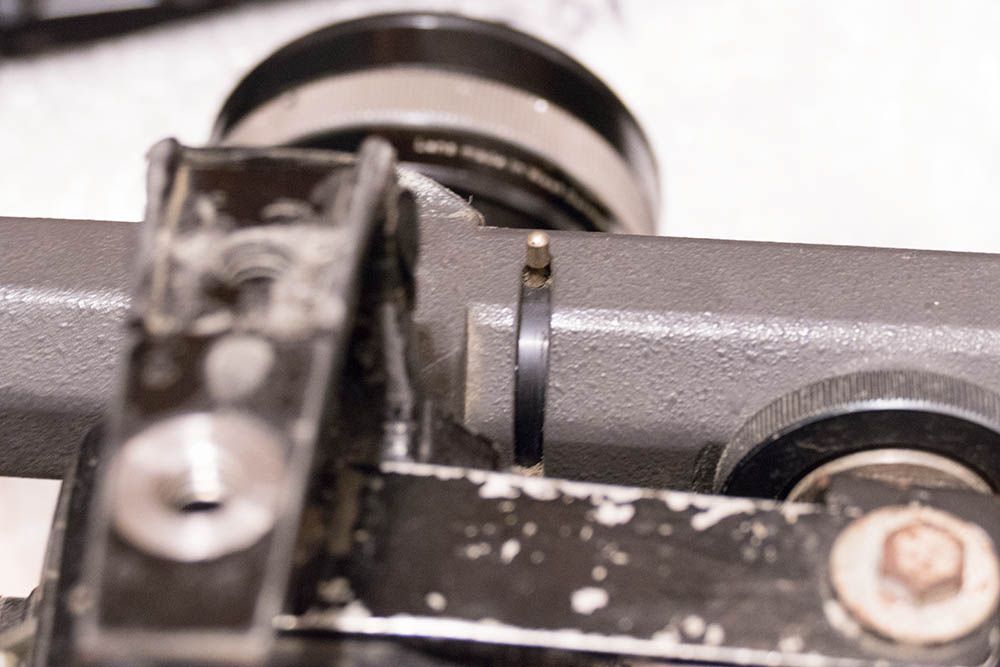-
Posts
220 -
Joined
-
Last visited
Posts posted by Scott Pickering
-
-
Im not sure where the eyepiece iris is. Bernie said he got it working, but wasn't sure why Im not getting an image. So somewhere Im missing something that people who know this camera would notice.
-
Bernie from Super 16 suggested to try and rotate the ring behind the viewfinder. There are two rings. See picture. Tried both but didnt see any change. The settings on this camera seemed to be so messed up from me figuring this out, that one thing seems to be affecting the next. So I can't confirm proper operation of the viewfinder.
-
-
Tried posting more photos but Photobucket is giving me the warning about 3rd party sharing. So this is all I can show you.
-
-
I found a lever switch on the t-bar which made me think that was what I was looking for. Tried it. No dice. Really don't know why it doesn't affect the prism, unless it needs power to work.
-
The camera has a dual outlet bar, one for each side, with the center holding both ends. I don't see any switch that would direct light. I have read video assists can lessen light, but the viewfinder is completely black. I don't see light coming through to the mirror either when I shine light through the viewfinder. So somewhere the light it being blocked. How I don't know. I don't see anyway of turning the t bar. It seems to be in place without movement.
I did email Bernie about this. Funny he never mentioned anything about it before.
-
Guys got the camera working with a new battery and its pushing film through. My only issue now is I can't get an image through the viewfinder, even when I rotate the mirror. I confirmed the lens is letting through light. There is a video assist on the opposite side, so Im not sure that is interfering with the viewfinder? What can I try to get an image? I can't focus or shoot anything if I can't see what Im looking at. Nothing is in the SR2 manual with this issue.
-
Shame you didn't contact me. I have a Switar 10mm I'd sell for not expensive.
-
Anyone have any updates on this yet? Perry- what was your decision in regards to getting one of these units?
-
Thanks guys. Looks doable then.
-
I need to put a test roll of film in this camera to confirm operation, as it was recently serviced and I got it back from that. Just need to show its working to potential buyers.
Without burning off a full 400 foot roll of film, can I safely run a 100 foot reel in this camera without damaging anything? Will the meter reader be able to show proper feet left or will the reel itself prevent that?
-
I think Laser IMAX can either go 1.90:1 or 1.44:1 depending on which screen is installed. Of course the film print I saw filled the whole screen as it should.
-
Just watched Dunkirk last night at the IMAX theater in 70mm. Its been so long since I've seen 70mm IMAX. First thing I noticed was the flicker in the image. You don't get that with digital projection. So right away I knew I was watching a film print. I noticed a few scratches blipping by in frames too, so yes it was film. The shots between 5 perf and 15 perf were noticeable. The 5 perf shots seemed more contrasty at times then the 15 perf. Blacks were darker. I assume this is because of the extra generation in the optical dupe. The 5 perf stuff held up well, and really weren't used all that often. They still had dialogue in some IMAX shots, so I assume they used ADR for that. There was more dialogue in the IMAX shots then 5 perf. 5 perf was probably for the closeups with dialogue. IMAX imagery was beautiful stuff. As per the other thread, there were a lot of focus problems in the movie and much shallow depth of field. All due to large format. And how smooth the image was in IMAX with detail thrown in. There wasn't a lot of saturation in the images at times, so I assume this was because of the optical print. Color between 5 perf and 15 seemed to change a bit as well. The 5 perf stuff didn't exactly copy the 15 perf. There was also a lot of handheld IMAX in this film, which was a bit much for me, as I tend to like steady images, especially in large format. It was hard to keep an eye on the image when it was moving so much.
All in all it was well worth seeing this on film and in IMAX. It was great to see the full screen filled up again and not just 3/4s of the screen like digital IMAX is. I wonder if my theater will take the opportunity to upgrade its digital projector to laser 4K IMAX while the film projector is being used. I doubt it though. I plan on seeing this at the same theater one more time with my pastor. I don't know how long this will be playing on film at the Langley theater.
-
I just watched the movie last night and also noticed this. I read in the article on ASC that the focus puller had to do it the old fashioned way- as he guessed a lot of the time what the focus should be. This probably accounts for why this happened in the movie.
-
I wish IMAX wouldn't try to supress 15/70, according to what I'm reading here. Its still the best format cinematically and no digital camera can touch it yet. I wonder how it is my Langley theater still has use of their 15/70 projector? They never removed it, but installed it all on rails, so it could be moved back into place when needed. That theater has been around since the late 90s, so I don't know how it is they decided to keep the projector instead of removing it. I'm glad they still have it. How did IMAX theaters ever make any money if it costs so much to use the 15/70 projectors?
-
 1
1
-
-
What they need to do is make some sort of sound blimp for the IMAX camera, or design a new IMAX camera that isn't noisy, and you'll see IMAX film cameras in more movies. The only reason Nolan could do so much of it in this film was the lack of dialog. But that won't fly on the majority of movies.
Nolan started to use IMAX cameras on Batman. That was trend setting. Films like Star Wars used the same method afterwards by using it in special scenes. Use of 5/70 is different. Far and Away was the start of reusing these cameras, though on that film the System 65 cameras was brand new. Then Hamlet. Then PT Anderson.
-
In70mm has some production notes about the film. I also read about the film not having much dialog, which Tyler mentioned as well, why they could use IMAX cameras for most of the film. If the film is really good, I may drive to see it in IMAX 70mm more then the one time I got tickets for. I don't know if there will be an opportunity to see true IMAX on film again after this movie, so I'm going while I can to see this one. Nolan is turning out to be one of my favorite directors and I agree with a lot of the decisions he makes on film making. If I were doing it, I'd probably do it the same as him.
-
Not true Tyler. "In70mm" has a list of what theaters are 5 perf and which are 15. This is how I found out the Langley theater here is showing it in 70mm IMAX. I already got my tickets for the show. Tickets are now on sale.
-
Price reduced to $2300 Canadian.
-
DMR isn't needed for this release, (or any release today), because its already scanned off film in high rez. DMR is only needed when doing film outs on 15/70 from scanned images off film or lower rez digital to begin with. Its totally not needed today because digital is already high rez enough, and shown in low rez 2K or 4K theaters, so up-rezzing is useless since its not shown in 70mm regardless. They just use the DMR tag today because it makes it sound good, even if irrelevant now.
As far as the release shown early on film, they did plan on doing this with Dunkirk, but because making the 70mm prints is taking so much time, they needed those extra 2 days to make the prints. Hence everything being shown on Friday, digital and film.
-
No kidding. Most of his movies have been getting longer with each release, and the later films were coming close to 3 hours in length. Being less then 2 hours for Nolan is a departure. But at least that means it should be tightly cut with no filler.
I'm really curious to see how the 5 perf shots will look on the IMAX screen. They advertised this as a DMR enhanced film, but I believe that may be inaccurate. I'm betting Nolan did optical dupes from 5 perf to 15 perf to maintain quality of the image. The 5 perf stuff should hold up pretty well on the large screen. Last time I saw 5 perf being shown on an IMAX release was Special Effects in around 96-97. It held up well then too, but its been a while since I've seen something like this.
-
According to Cineplex Canada, Dunkirk is 1 hour 47 minutes long. With 100 minutes of IMAX footage, that would mean only 7 minutes of the film are actually in 5 perf 70mm. So pretty much most of the film was shot with IMAX cameras.
The only 100% IMAX movie was Wings of Courage, and it was a shorter movie at that. Dunkirk marks the most use of IMAX film cameras for a Hollywood feature.
-
I went to the Langley theater today that has the old IMAX theater in it. I got confirmation they are showing Dunkirk in 15 perf 70mm film print. Apparently they never removed the old IMAX film projector, but installed it on a rail system so the two projectors could slide one out and the other in place for a show. She also confirmed they haven't used the film projector in 4 years (last time was Nolans Batman 3 film). She said IMAX was sending out a projectionist just for Dunkirk to make sure the IMAX film print goes without a hitch. Makes sense as what current employee would know how to setup a film projector these days?
I don't know why Interstellar didn't get a 70mm film print for this theater, but with all the 70mm hype of late, Nolan's push to show it on that finally stuck with theaters across the world. I did ask her if they'll use the film projector for movies like the up and coming Star Wars. She said she didn't know, but it didn't sound like it will happen. Its all up to the movie companies whether they want to show it on film or not. Nolan has the push to do it.








Arri SR2- Working?
in ARRI
Posted
Solution found. You have to press some pressure on the eyecup itself, which opens the iris blades to see through. Once I did that I could see the image from the lens. Thank you for helping me with this guys. Im glad this thing isn't broken.